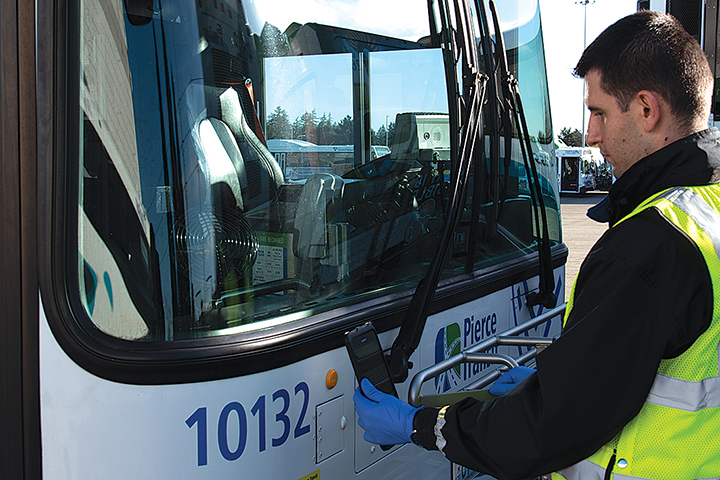
Modern data programs make it easier for IT teams and transportation officials to stay connected.
The sheer volume of information required to successfully run any private or public transportation fleet is astonishing.
There’s data from inventory control, purchasing, scheduling, routing, accounting, and human resources—and that’s just the tip of the iceberg. Fleets also generate important data from inspection and incident reports, general maintenance, idle times, and fuel usage.
The challenge is connecting it all in a way that makes sense in real-time, within budget. As adoption increases for IOT technologies, decision-makers are turning to the cloud to modernize operations.
The Big Advantage of Cloud Solutions for Every Fleet
The digital shift in private and public transportation has been decades in the making. As programs, processes, and demands grow in complexity, decision-makers need the same thing: actionable insights. That means route planners, stockroom clerks, bus dispatchers, HR personnel, mechanics, drivers, and riders can get critical information on demand.
Each stakeholder wants insights presented in a way that’s intuitive, multi-purposed and doesn’t require an advanced analytics degree to understand. For example, fleet managers want insights to track assets and maximize asset output. This data can show vehicle locations and activities, which is useful information for payroll.
Cloud technology enables near-real-time access to IOT data at a large scale for fleets of any size and purpose. These high-performing data programs give decision-makers a broad view of fleet data, across thousands of vehicles, so they can run operations at-scale without surprises. It’s one thing to track the location and status of fleets. It’s another to contextualize it. This approach helps prioritize what needs action now or in six months, whether it’s changing routes, scheduling alternate drivers, or planning for major maintenance.
Cloud Technologies One Layer Deeper: The Data Stream Vs. the API Model
Data is only as good as the insights you can glean to take action. Cloud technologies give users the ability to manage real-time data and develop predictive models with AI and machine learning, with a significantly smaller financial investment than many on-prem solutions.
Not to get too technical, but let’s look at how data in the cloud is delivered. Typically, it’s via digital data streams or an Application Programming Interface (API), that enables two software components to communicate with each other using a set of definitions and protocol. Both have their benefits, but key considerations are in the resources required to manage data, the ease of integration and creating custom projects, and the overall cost to transfer and use data.
Data streams are often more efficient for flowing, delivering, and integrating data. Consider the earlier example about fleet managers and payroll. A data stream delivers information when an event happens. An API model, on the other hand, typically results in duplicate data and higher data transfer costs because it’s a call-and-response approach. You need to initiate a query any time you want to know your vehicle’s current location.
What Cloud Tech Means for the Future
While the principles may be similar across fleets and agencies, one size does not fit all. All fleet operators are best served by flexible solutions that can be customized to their environments and integrated into other parts of their operations.
Rather than invest in solutions that try to be everything to everyone, savvy operators want technology that’s tailored for their specific market to—first and foremost—enhance rider safety, keep the public informed, and maximize efficiency.
Cloud technology not only costs less than on-premises data management solutions, the savings and ROI is exponential. With better-connected data, fleet operators can uncover hidden costs and identify more efficient ways to use and route transportation assets based on vehicle usage, fuel efficiency and vehicle health.
Other applications include the ability to connect to your engine to monitor and diagnose system alerts. This can be a crucial piece to keeping your transportation system running within budget.
Additionally, transportation directors gain complete visibility into fleet location and improved communication between dispatchers, drivers, and fleet managers, which can be especially useful with new or alternate drivers.
Innovative Solutions for All
The growing trend among innovative fleet managers is that they want to know the entirety of their operations and their transportation programs. When it comes to transportation, they’re investing in the cloud.
Modern telematics systems go above and beyond GPS capabilities. Cloud technologies help motorcoach companies, public transit agencies, paratransit, shuttle travel, and tour providers manage their fleets, spot trends, uncover wasteful spending, and receive proactive alerts to any range of metrics and measurements.
The big picture is that useful advances in cloud technology are becoming more attainable. And with that, fleet managers can make more sense of the groundswell of data they’re creating, leading to better decisions to make all transportation safer and more efficient.
H. Kevin Mest is senior vice president and GM of passenger services, Zonar Systems. Visit www.zonarsystems.com for more information.
